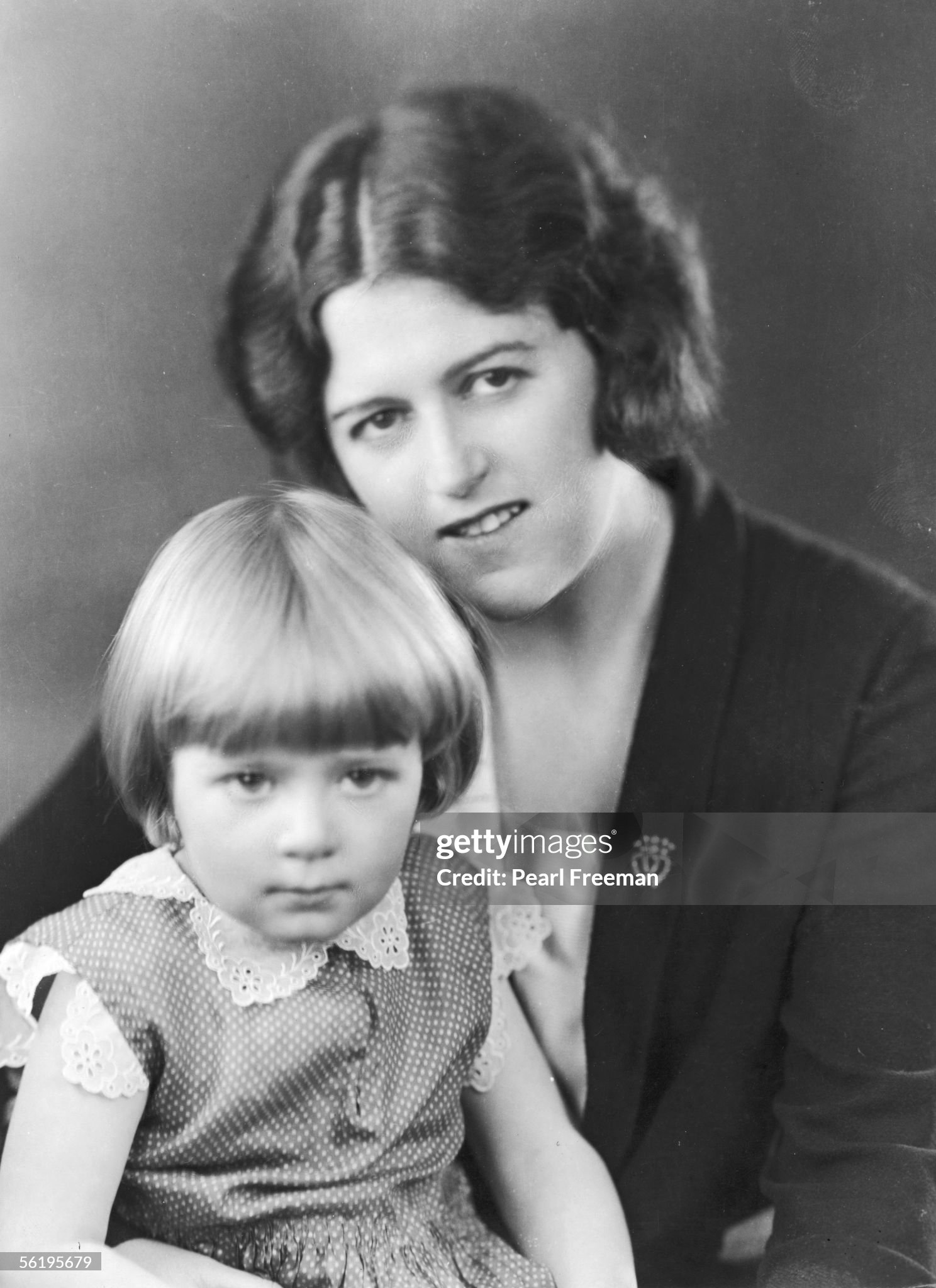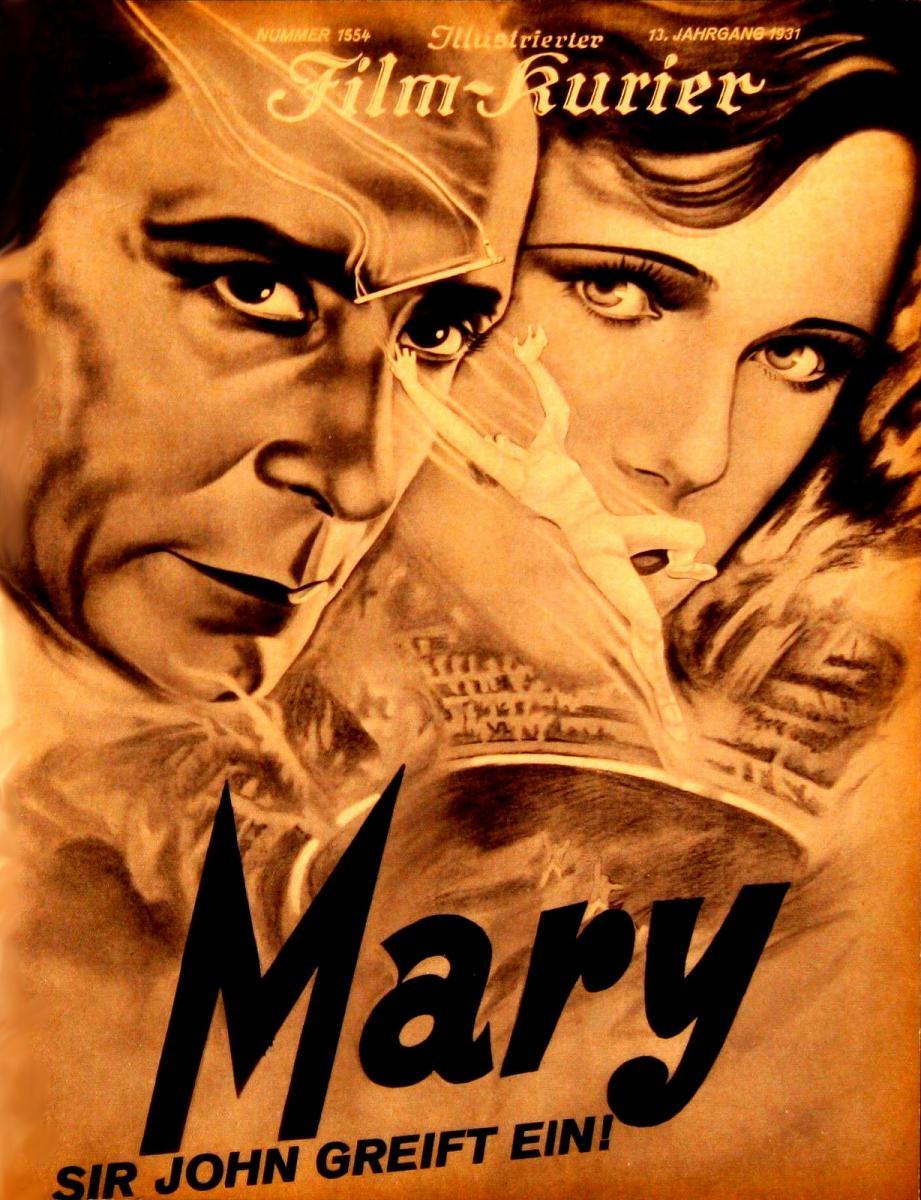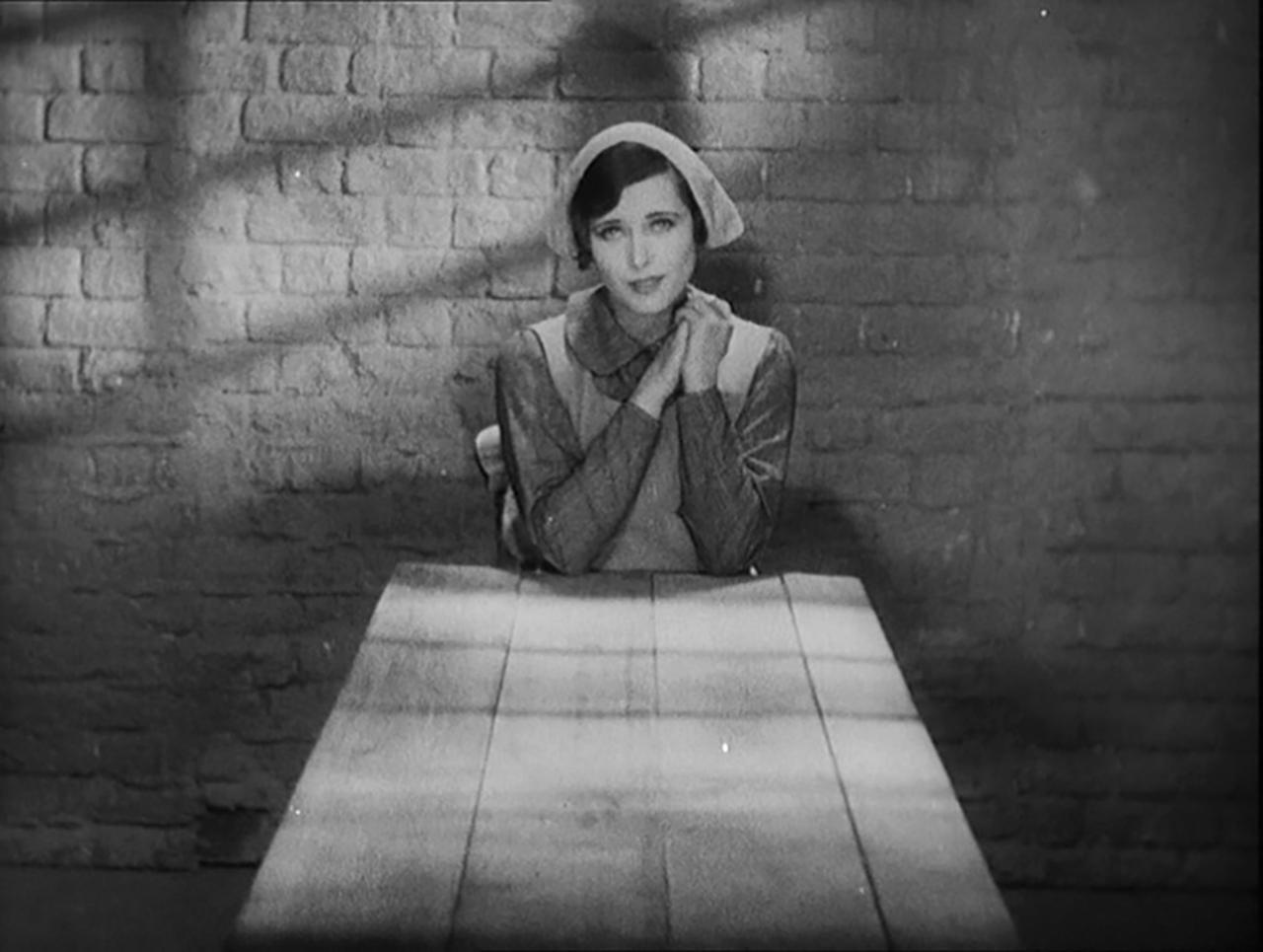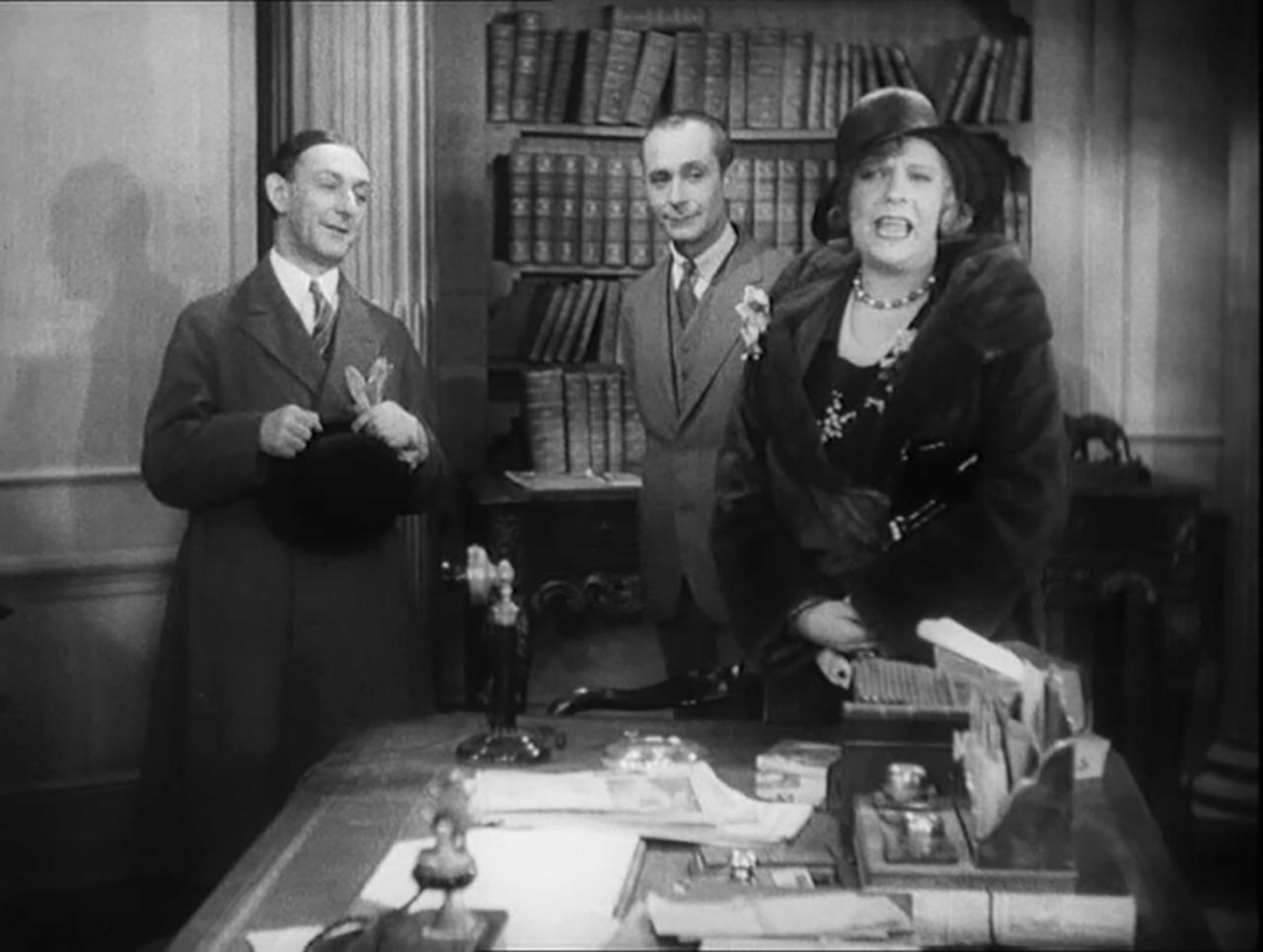- In 1956, the Master famously remade his own 1934 thriller The Man Who Knew Too Much
- But 26 years before that, he directed two very different versions of this murder mystery
- Both films were shot at the same time and place but with two English and German casts
- Source novel author also penned Hitchcock’s experimental costume drama, Under Capricorn
Note: this is part of an ongoing series of 150-odd Hitchcock articles; any dead links are to those not yet published. Subscribe to the email list to be notified when new ones appear.
Murder! and Mary, Part 2: Home video

US window card
Contents
- Murder! (1930)
- Mary (1931)
- Related articles
Murder! (1930)

The director flanked by his leads in both MLVs: Norah Baring, Hitch and Olga Chekhova, respective stars of Murder! and Mary, conflab on the set
Diana Baring, an actress in a touring company, is discovered near the scene of the crime when a woman is found murdered. She is charged with the murder, placed on trial and convicted on circumstantial evidence. One of the jury, however, Sir John Menier, believes in her innocence and undertakes to prove it. His personal investigations take him to the touring company where he questions members of the cast and others. Through the girl’s landlady he hears that a man’s voice was overheard near the scene of the crime on the night of the murder and, eventually, he tracks down the killer in an exciting climax in a circus tent. – US Republic Pictures VHS (1994, ad) and Australian Polygram VHS (1995)
Writing in 1930, the critic and documentary maker John Grierson CBE (1898–1972) infamously proclaimed:
“Hitchcock is the best director, the slickest craftsman, the sharpest observer and finest master of detail in all England. There is no doubt about this. He has these qualities so abundantly that in their sum they give him a style which is his and no one else’s. A Hitchcock film is a Hitchcock film—and never a bad one—and this, if you will believe me, is an achievement of character where so many hands, grubby and otherwise, contribute to the final result of a film. Yet for all these virtues, Hitchcock is no more than the world’s best director of unimportant pictures. Not one he has made has outlasted a couple of twelvemonths, or will—unless something radical happens to change his standard of satisfaction and give his talents something solid to be bright about.”
Ouch. He was, of course, making the point that in his opinion, Hitch’s prodigious talent should be turned towards making films based on more important subjects than mere escapist entertainment like this. He then went on to review both Murder! and Rich and Strange in great and thoughtful detail. Much later, director John Frankenheimer broadly echoed his sentiments but it still sounds like sour grapes to me—and Grierson was wrong about them not lasting longer than a couple of years…
Hail Hitchcock and Murder! – Film Weekly
Even so, as with so many of Hitchcocks, Murder! and its German-language sister, Mary, are best known these days for having been directed by our Alfred. Just as interesting though, is the fact they’re multiple-language version (MLV) films , shot simultaneously on the same sets but with different casts. Filming took place from March–May 1930 at British International Pictures’ London studios, as with all of Hitch’s films made for the company from The Ring to The Skin Game. The Hitch-produced Lord Camber’s Ladies was also shot there and he returned years later to use the facilities for Jamaica Inn and Stage Fright.
Hitch doesn’t have a cameo in the German MLV but one actor does appear in both. Miles Mander, psychopathic star of The Pleasure Garden, partly shot in Germany, was already a veteran of several other German films and fluent in the language so reprised his role as the victim’s husband.
Both Murder! and Mary are densely plotted mystery-thriller whodunits with numerous typically Hitchcockian twists, though Mary is 20 minutes shorter than Murder! so much more streamlined. A third version, presumably French, was initially proposed but didn’t transpire. This was actually Hitch’s second experience with MLVs, as the previous film he worked on, Elstree Calling, was completed in nine different languages.
Illustrierter Film-kurier, no. 208
Murder!/Mary’s source text is 1928 British novel Enter Sir John, also serialised the same year in US publication Nash’s Magazine before being published complete a few months later. Both were graced with gorgeous illustrations by Sydney Seymour Lucas, the accomplished artist son of renowned Victorian painter John Seymour Lucas. It was written by Clemence Dane, the pseudonym of Winifred Ashton, who was by all accounts an unwittingly hilarious conversationalist, and Helen Simpson, who later mounted a parallel career as a liberal politician until her untimely early death.
Ashton racked up an impressive tally of film and TV credits and though this was her only official connection with Hitch, she also carried out the initial, uncredited, adaptation of Jamaica Inn and her own annotated script sold in early 2013; if its buyer should read this, please get in touch!
Murder! Theater, Authorship and Camera Presence – William Rothman

Helen de Guerry Simpson and her daughter Clemence, named after her sometime writing partner Clemence Dane, c.1925
Australian-born Helen Simpson packed a lot of pursuits into her years: actor, poet, novelist and politician to name just a few, before dying tragically young in 1940 at the age of 42. Though most of her novels and copious other writings are long out of print, the screen adaptations arising from some of them are thankfully all easily available. Following Saraband for Dead Lovers (1935, adapted for a 1948 film), she provided additional dialogue for Sabotage, her only actual screenwriting credit. Lastly to date, she wrote Under Capricorn (1937) which, of course, became a 1949 film directed by Hitch and a 1982 TV miniseries was made in Australia, the country of its setting.

In the director’s customary cameo, he’s walking past house number 13, surely a subtle nod to his unfinished first film. But why’s that errant spotlight in the frame? Here’s the answer.
Despite various authors repeating the claim the pair’s Enter Sir John was adapted for the stage, according to film historian Charles Barr in English Hitchcock (1999), there’s no record of that ever happening. The rumour seems to have come about due to Dane also being a successful playwright and the fact that as the book is set within the world of the theatre, the films naturally come across as if they were play adaptations. Much like the oft-repeated falsities of The Mountain Eagle being renamed in the US, or Nita Naldi’s supposed appearance in The Pleasure Garden, the Murder!-play misapprehension has been perpetuated by numerous lazy authors and non-existent fact checking. For all that, Enter Sir John did at least spawn a rare 1932 sequel titled, somewhat predictably, Re-enter Sir John, and the pair collaborated on one other novel, 1930’s equally rare Printer’s Devil (US: Author Unknown).
On the subject of associated books, I strongly recommend Hitchcock Lost and Found: The Forgotten Films (2015) also by Barr, with Alain Kerzoncuf. It has a substantial chapter on both MLVs, with an in-depth analysis of their production and many fascinating differences. Another important print resource is the aforementioned English Hitchcock, while there’s an extensive breakdown of Murder’s sound design in:
- First Experiments with Sound: Blackmail and Murder – Elisabeth Weis, The Silent Scream: AH’s Soundtrack (1982) info

UK Studiocanal DVD; Norah Baring in Murder! Otherwise best remembered for leading roles in Anthony Asquith’s silent dramas Underground, The Runaway Princess and A Cottage on Dartmoor, she also interviewed Hitch in 1935 for her regular column in Film Pictorial.
Following the, ahem, execution of its titular subject matter, Murder! threatens to devolve into a similar, albeit highly stylised, vein as later classic courtroom dramas such as 12 Angry Men (1957), before moving firmly into whodunit territory. There are some keenly observed performances from the usual array of Hitch regulars, both credited and uncredited. In particular, look out for former Blackmailer Donald Calthrop, who puts in a brief but nimble turn as both a policeman and a damsel in distress! Without wanting to spoil the outcome, it’s previously often been claimed the killer commits their crime to protect the dreadful secret that they’re actually gay. This is incorrectly seen as a subtext instead of the real reason stated in both the book and film, which happens to be something of which I myself am thoroughly, yet unashamedly, guilty. How times have changed.
In the novel, the killer escapes his captors and permanently disappears, while in Mary his motivation is protecting the more conventional secret that he’s an ex-convict.
A question: there are various timepieces seen during the course of the film, and all display 1:30, either am or pm. I’m well aware of Hitch’s general predilection for clocks, watches, etc. but does anyone know the reason for this particular time? [Edit: Hitch fan Matthew Hardesty has suggested a very plausible explanation in the comments.]
Distinguished British actor Herbert Marshall played Sir John himself and during a lengthy transatlantic career went on to star in Hitch’s second American film, Foreign Correspondent, the Hitch co-scripted Forever and a Day and three episodes of Alfred Hitchcock Presents. There were also several Hitch-related radio dramas: The Lodger, two of The 39 Steps, Rebecca and, by strange coincidence, the July 20, 1953 Lux Radio Theatre adaptation of Daphne du Maurier’s 1952 short story “The Birds” – a full 10 years before the release of Hitch’s screen version! The actor had a very colourful love life and the second of his five wives was fellow Brit Edna Best, star of the original The Man Who Knew Too Much. The pair had a daughter, actress Sarah Marshall, who also starred in five episodes of Presents/Hour and associated series Startime.
Herbert Marshall: A Biography (2018) – Scott O’Brien
Mary (1931)

German Illustrierter Film-Kurier/alt; Filmwoche, Filmwelt
Murder II: Hitchcock’s German double – Richard Combs
One interesting wrinkle in Mary’s history is that some Austrian trade papers initially posted notice of a full colour production. According to film history sleuth and Nosferatu expert Martin H. Larsen, “it sounds like an intriguing mystery, with the first mention in the weekly Österreichische Film-Zeitung (Austrian Film Newspaper), 14 June 1930:
The sensation of the coming season!
The great German colour sound film
MARY
Based on one of the most successful English stage plays
100 percent sound – 100 per cent German dialogue
100 percent colour
Two pages later in the same issue there is an article on upcoming Sascha Film releases which again mentions it specifically as a color film:
The great German colour sound film Mary, based on one of the most successful English stage plays, can also be described as a sensation of extraordinary rank, with which our sound film theatres will do unparalleled business. This film, directed by the famous English director Alfred Hitchcock, is entirely in natural colours and has 100 percent German dialogue. One can indeed expect a quite fabulous attraction here, all the more so as artists such as Olga Tschechowa, Alfred Abel, as well as Paul Grätz, Fritz Alberti, Herta V. Walter and Louis Ralph play the leading roles.
Also on 14 June 1930 another Austrian film newspaper, Das Kino-Journal, has a similar ad for a color Mary. However, it appears that after this color is no longer mentioned. In another example from Österreichische Film-Zeitung , 9 August 1930, is an article where Mary is described several times as a sound film, but color is not mentioned:
Under the direction of the most capable English director, R. Hitchcock, another super film has just been produced: Mary, (Murder!), the screening of which was a resounding success. It is reasonable to expect that under Hitchcock’s master direction, German actors such as: Alfred Abel, Olga Tschechowa, Fritz Alberti, Lotte Stein, Hertha von Walther, Paul Grätz, Eckehardt Arendt will also give first-class performances. The production, which is based on one of the most successful plays (Enter Sir John) – edited by Juttke and Klaren – is of ravishing suspense and shows great scenery. The backdrop for the events is the theatre milieu, which has been given a whole new dimension by the sound film.
From the same newspaper, an ad from 4 October 1930 again mentions sound film but no color. All in all it’s possible that there had been some kind of confusion on Sascha Film’s behalf, and the fact that all mentions are from a specific date only (June 14 1930) points in this direction.”
It’s almost certainly due to a simple mix-up; note too the erroneous mentions of the film being based on a stage play. Advertised alongside Mary in the foregoing papers is Hitch’s last outing, Elstree Calling (“German title undecided”), with various other MLVs. That had some colour sequences added to its B&W negative but he wouldn’t make a full colour film until 1948’s Rope. What’s more, both extant negatives of Murder! are also B&W – remember: both films were shot at the same time with the same equipment and crew. Further, factor in it’s virtually inconceivable that if Hitch had shot a single frame anywhere in colour before 1948, he wouldn’t have mentioned it in any of his copious articles and interviews. Nonetheless, please leave a comment below if you can throw any further light on this curiosity.
Lastly, in the early sound era full colour features were almost exclusively American, with the only British example being sadly lost The School for Scandal (1930) starring Madeleine Carroll and uniquely shot in the Raycol process. Three-strip Technicolor, the first really successful and widely adopted process, wasn’t introduced until 1932 and initially appeared solely on American cartoons, shorts and isolated sequences. 1935 period drama Becky Sharp was the first to use it wholesale, while the first British production to do so was 1937’s Wings of the Morning. The former film is in the public domain and had any number of crappy quality releases but only a few boasting UCLA’s magnificent 4k restoration.
- Prime Video HD – trailer
- US: Kino BD and DVD (2019)
Unrestored PD DVDs: France (Bach), Italy (A&R Productions), Spain (Vértice), US (Alpha, St. Clair Vision, FilmRise, Reel Vault, Starry Night, Synergy, Triad).
- Wings of the Morning : Prime Video HD – trailer
- US: Kino 2on1 DVD (2003) w/St. Martin’s Lane (1938)
- UK: Screenbound 2on1 DVD (2020) w/The Golden Madonna (1949)

Olga Chekhova playing the accused in Mary; more
Murder! and Mary, Part 2: Home video
Related articles
This is part of a unique, in-depth series of 150-odd Hitchcock articles.
- The Multiple-Language Version Film: A Curious Moment in Cinema History
- Multiple-Language Version Film Collectors’ Guide




This site claims that the new Blu-ray of Murder! will be the 2012 BFI restoration and Mary will be “Up-res” whatever that is.
“Kino’s press release promised the inclusion of a “Hitchcock: The Early Years documentary (52:22)” but it’s disappointingly absent.” I was wondering if this might have been an odd renaming of the “Pure Cinema: The Birth Of Hitchcock Style” extra from the 2007 Lionsgate US box set, but after digging out my copy I found that it was a 15 minute featurette. That got me curious, and after some digging it appears that the 2007 Optimum UK box set had this documentary. From the 2008 Gary Couzens review on The Digital Fix: “This is a French-made film, directed by Noël Simsolo.… Read more »
Up toward the beginning, your link to the annotated script no longer works.
You asked about the significance of 1:30 seen on all the clocks in Murder! This could be the root of a clock motif that is more forward in Rear Window. There, Hitch is winding a clock in his cameo. Jimmy Stewart’s character hears an object smash in relation to the murder, which could be a clock. He sees the couple caught in the rain accidentally smash their alarm clock. The clock is a symbol of death. For the time 1:30, in numerology (which I don’t ascribe to) 130 = 10 × 13, both the unlucky 13 and the perfect 10.… Read more »